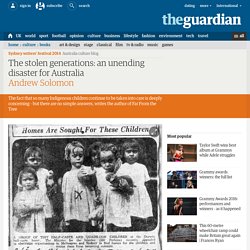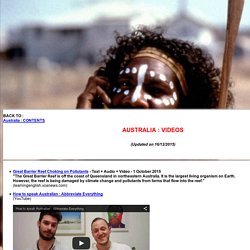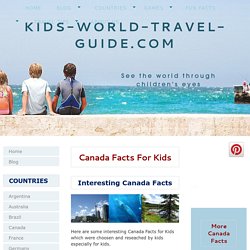

Start exploring Australian Aboriginal culture. Where did English come from? - Claire Bowern. There are two other TED-Ed lessons related to this topic: How languages evolve and How did English evolve?

(a lesson that fills in some of the details that we omit here due to the fact that the focus of this lesson was further in the past). There is still a great deal of debate about Indo-European, most importantly about the location of the homeland. To read more about this debate, there are classic books by Mallory and Renfrew, as well more recent works by Anthony. Then, read these articles by Bouckaert et al. At the same site, watch this movie that shows one hypothesis about how Indo-European languages expanded. To learn more about the distribution of languages across the world, see LL-map or The Ethnologue. A day in the life of a child in Kenya. Scenes from schools around the world. The Stolen Generation. The stolen generations: an unending disaster for Australia. Lynne, the sister of a close friend in Philadelphia, became a foster parent a few years ago.

She and her partner, Mandy, were assigned a little boy whom I will call Diery. He had lived his first six months in the care of a mother who abused drugs and abused him, and he was bruised both physically and psychologically. Over the next three years, Lynne and Mandy slowly rebuilt him, and under their care, he thrived. He was a happy, intelligent, secure little boy.
Lynne and Mandy were told that they would be able to adopt him, and they began the legalities of doing so. But when he was three and a half, his biological mother initiated the process of reclaiming him. Nonetheless, social services prioritised the birth mother, and after a few months of battle, he was returned to her. That’s traumatic for them, of course, but it’s hard to believe it’s not yet more traumatic for him. There are two questions attached to the removals idea. Australia is hardly alone in such a history. Australia Time Clock & Map - Check Time in Australia. Time in Australia Australian continent stretches out over three time zones.

Because Australia is situated west to the International Date Line, it is ahead of time compared to most other countries of the world. The proper names of Australia's time zones are: Australian Western Standard Time - UTC+08 (AWST), Australian Central Standard Time - UTC+09:30 (ACST), and Australian Eastern Standard Time - UTC+10:00 (AEST).
Australian Eastern Standard Time (AEST) Australia Day - Interactive ESL Crossword Puzzle. 25 Facts About Australia That Show Why It’s So Unique. Australia : Videos. Where the bloody hell are you?

- "An Aussie tourism ad, banned in the UK. " (YouTube) Script : "We've bought you a beer. We've had the camels shampooed. We've saved you a spot on the beach. And we've got the sharks out of pool We got the roos off the green. Canada Facts for Kids: Interesting and Fun Facts about Canada. Here are some interesting Canada Facts for Kids which were choosen and reseached by kids especially for kids.

Population: 35,4 million people (2014)Capital: Ottawa 950,000 inhabitants (2014)Name: CanadaGovernment: DemocracyLanguages: English, FrenchReligion: mainly Christians (Roman Catholics and Protestants)Currency: 1 Canadian Dollar (CAD)=100 Canadian centsNational Symbols: Maple Leaf and BeaverHistory: Canada's biggest bay, Hudson Bay, was discovered in 1610. Since the 16th century, both French and English kings have ruled over the country. Canada gained independence from Britain in 1867. Today, Queen Elizabeth II (of England) is still also the Queen of Canada and the head of state. The prime minister elected by the people is Justin Trudeau. Canada Map: Where is Canada? Canada Map Canada is in Northern America and shares borders with the United States of America. Polar bears in Churchill. Canada.
Untitled. Australia Facts for Kids: Facts about Australia for Kids. Interesting Facts for Kids Here are some interesting Australia Facts which were chosen and researched by kids especially for kids.

Name: Commonwealth of AustraliaGovernment: DemocracyPopulation: 23, 6 million (2013)Capital: Canberra with 380,000 people (2013)Language: English Australia Geography Australia is the smallest inhabited continent of the seven continents can also be considered the largest island in the world. In fact it is an island continent. The country is divided into six states (Southern Australia, Western Australia, New South Wales, Queensland, Victoria and Tasmania) and two self-governing territories: Northern Territory and Australian Capital Territory (which is around Canberra, the capital city).